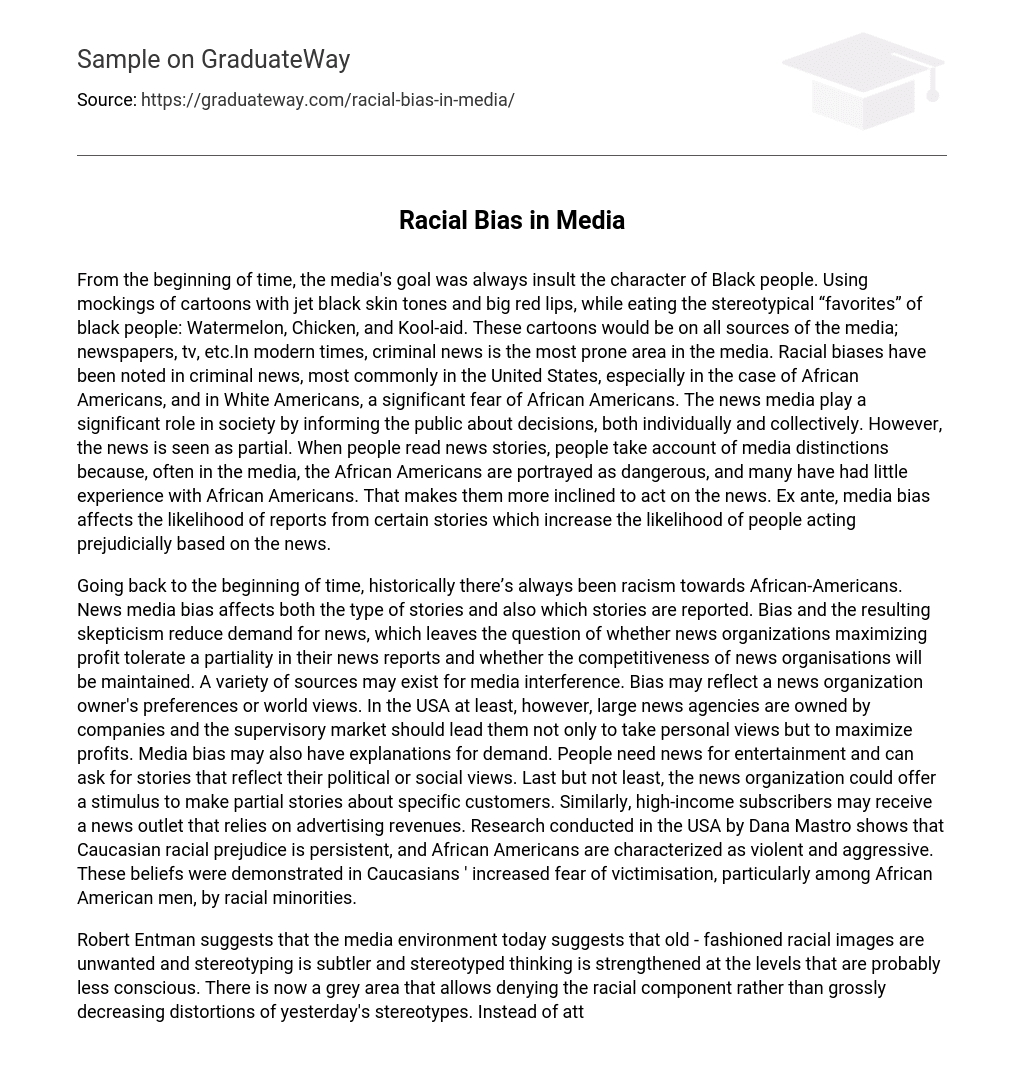From the beginning of time, the media’s goal was always insult the character of Black people. Using mockings of cartoons with jet black skin tones and big red lips, while eating the stereotypical “favorites” of black people: Watermelon, Chicken, and Kool-aid. These cartoons would be on all sources of the media; newspapers, tv, etc.In modern times, criminal news is the most prone area in the media. Racial biases have been noted in criminal news, most commonly in the United States, especially in the case of African Americans, and in White Americans, a significant fear of African Americans. The news media play a significant role in society by informing the public about decisions, both individually and collectively. However, the news is seen as partial. When people read news stories, people take account of media distinctions because, often in the media, the African Americans are portrayed as dangerous, and many have had little experience with African Americans. That makes them more inclined to act on the news. Ex ante, media bias affects the likelihood of reports from certain stories which increase the likelihood of people acting prejudicially based on the news.
Going back to the beginning of time, historically there’s always been racism towards African-Americans. News media bias affects both the type of stories and also which stories are reported. Bias and the resulting skepticism reduce demand for news, which leaves the question of whether news organizations maximizing profit tolerate a partiality in their news reports and whether the competitiveness of news organisations will be maintained. A variety of sources may exist for media interference. Bias may reflect a news organization owner’s preferences or world views. In the USA at least, however, large news agencies are owned by companies and the supervisory market should lead them not only to take personal views but to maximize profits. Media bias may also have explanations for demand. People need news for entertainment and can ask for stories that reflect their political or social views. Last but not least, the news organization could offer a stimulus to make partial stories about specific customers. Similarly, high-income subscribers may receive a news outlet that relies on advertising revenues. Research conducted in the USA by Dana Mastro shows that Caucasian racial prejudice is persistent, and African Americans are characterized as violent and aggressive. These beliefs were demonstrated in Caucasians ‘ increased fear of victimisation, particularly among African American men, by racial minorities.
Robert Entman suggests that the media environment today suggests that old – fashioned racial images are unwanted and stereotyping is subtler and stereotyped thinking is strengthened at the levels that are probably less conscious. There is now a grey area that allows denying the racial component rather than grossly decreasing distortions of yesterday’s stereotypes. Instead of attacking racial identity, the term ‘threatening black male’ enables a negatory attribute. The study carried out in Race and Punishment says that existing crime coverage strategies are designed to increase the importance of a crime and thereby distort the public sense of who commits crimes and give rise to partial reactions. It overstretches African Americans and downplays victimization of African American people by over – representing Caucasians as victims of the crime perpetrated by colored people. For instance, most US homicides are intraracial, but media reports often portray a world with an over representation of African American male offenders.
Sentencing Project study reports that African American suspects were presented in more threatening situations than Caucasians; more often than not they were labeled African American suspects and shown to be threatening by being depicted in police physical custody. Television news studies consistently show that African American men, compared with their TV counterparts from the Caucasian male and reports from real-world Justice Departments, are over-represented as perpetrators and under representated as victims. African American suspects are more likely to be portrayed in these news stories than Caucasians as unnamed, menacing and politically capable than Caucasians. Some evidence also suggests that audiences know the news they watch misrepresents the reality of race and crime in the United States, and that news executives know their broadcasts scare their audiences. In addition to their overrepresentation as criminals in the news, African Americans are also underscribed as victims compared to their on – air counterparts. In addition to crime text, Dana Mastro reports that African Americans are nearly four times better represented as criminals than police officers in TV news. When people constantly consume in crime – related news stories the persistent overrepresentation of Afro – American men strengthen their cognitive association between Blacks and criminality, such as the link between Black people and crime, and so become chronically accessible in race – related assessment. Notably, as media priming research shows, even a single exposure to such unfavorable characteristics may give rise to stereotypical responses.





